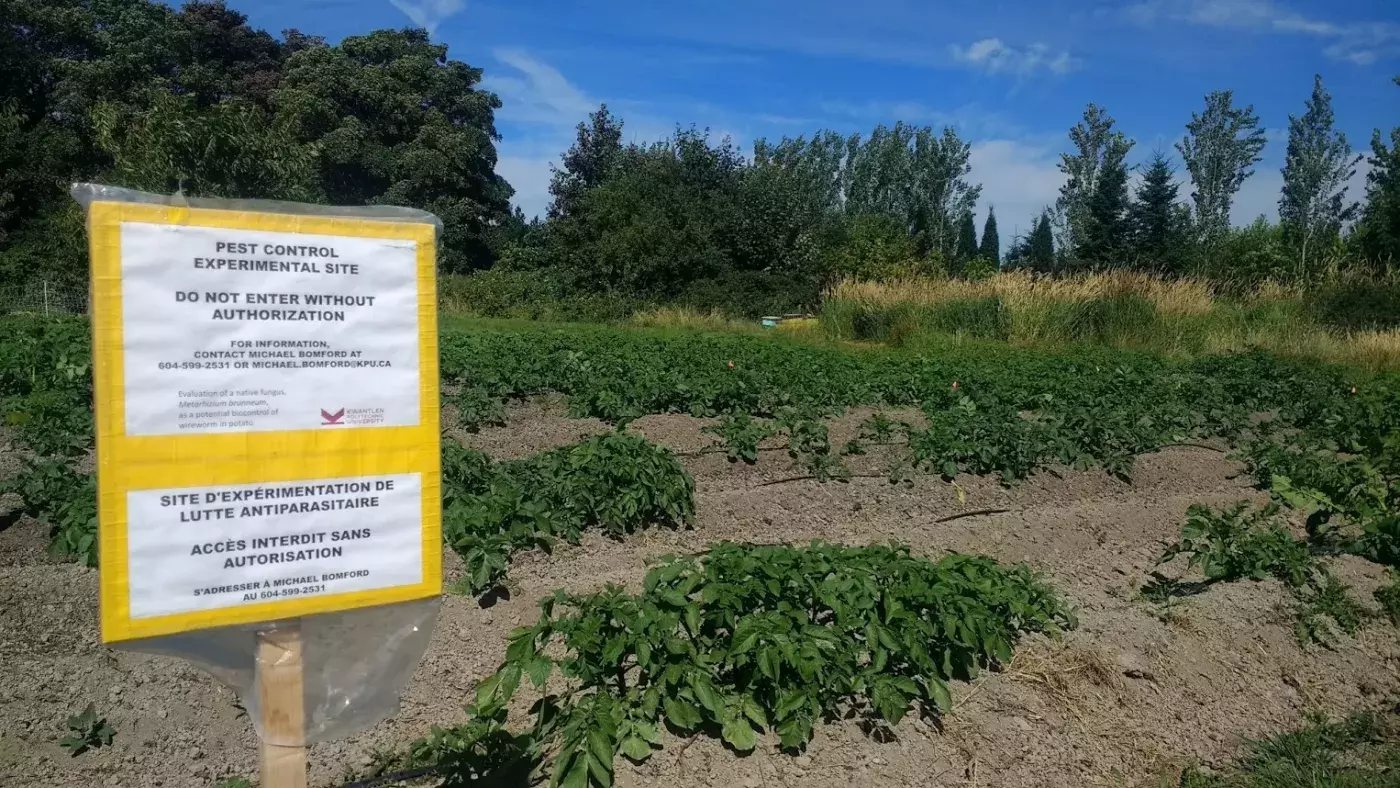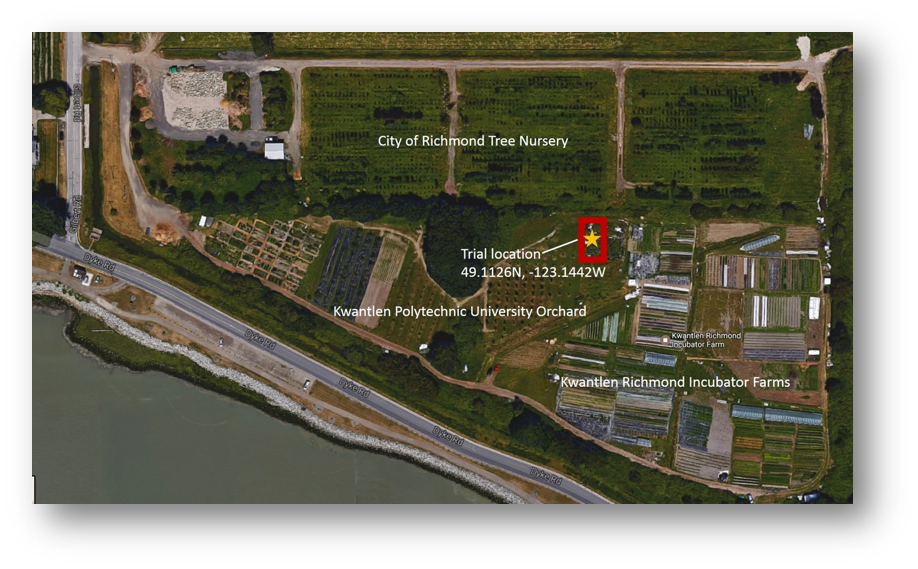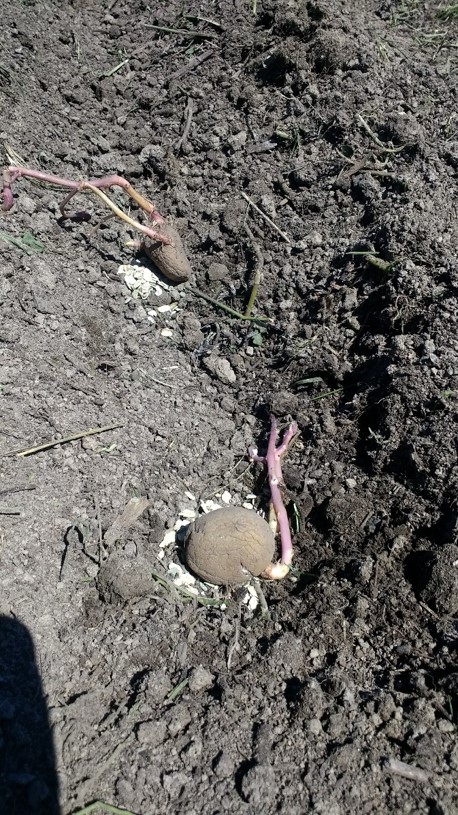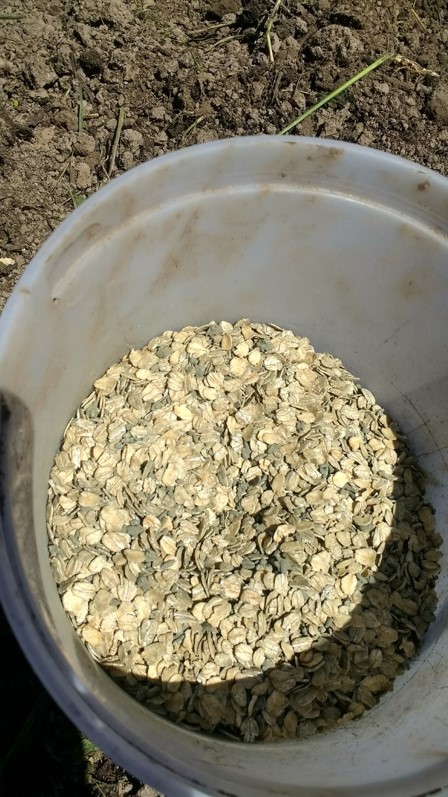
Biocontrol of wireworm in potato with entomopathogenic fungus

Experimental Research by Isabel Aida Stewart, Sustainable Agriculture and Food Systems Student, 2017
Image

Objective: To test the efficacy of an entomopathogenic fungus with, and without rolled oats, as a bio-control of wireworm in potato grown in Richmond, British Columbia.

Introduction
The wireworm (Agriotes lineatus) is the larval stage of the click beetle. Its broad host range includes carrots, cucurbits, rutabagas, onions, sweet corn, potatoes, sugar-beets, beans, and peas. It tunnels into potato tubers, rendering them unsuitable for sale, and reducing crop yield.
Organophosphate insecticides that have historically been used to control wireworms are detrimental to ecosystems, threaten human health and well being, and are not permitted for use by organically certified farming operations. Recently, some wireworm populations have developed a resistance to some organophosphates; at the same time, many such synthetic pesticides are no longer registered for agricultural use in Canada. Potential alternatives are the use of non-toxic biological controls, often in the form of bacterial, fungal or nematode agents.
Metarhizium brunneum is an entomopathogenic fungus that kills wireworms, making it a potential biological control agent. Previous studies have found it to be effective in reducing crop damage associated with wireworm feeding (Ansari et al., 2009; Kabaluk et al., 2017; Brandl et al., 2017; Reddy et al., 2014). Wireworms are attracted to CO2 released through plant roots, and decaying rolled oats also release CO2, making them a potential lure to attract wireworms to M. brunneum. Assuming that rolled oats might help attract wireworms in this way, we tested the efficacy of M. brunneum with, and without rolled oats, as a biocontrol of wireworm in potato grown in Richmond, British Columbia.
Image
 |
Fig 1. Research site (red box with star) at the Kwantlen Polytechnic University Orchard in south Richmond. |
Methods
The study was conducted on a 200 m2 section of the Kwantlen Polytechnic University orchard, at the corner of Gilbert and Dyke road in south Richmond, B.C. (Figure 1). It employed a Randomized Complete Block Design with six replicates and three treatments (Figure 5):
- M. brunneum and oat (Metarhizium);
- M. brunneum without oat (MetaOat); and
- Untreated control (Control).
On July 23rd, each experimental plot (2 x 4 m) was planted with 21 seed potatoes (cv. ‘Orchestra’), spaced 30 cm apart in three rows spaced 1 m apart. A 1 m unplanted buffer was left between plots in each row. Four grams of cultured M. brunneum on rice was deposited below each tuber in the two M. brunneum treatments. The cultured fungus was blended with rolled oats in the MetaOat treatment only (Figures 2, 3). Potatoes were hilled after seeding and just before row closure.
Potatoes were then harvested from the centre row of each plot on October 13th. Plant count, potato count, total yield, wireworm-damaged yield, and degree of wireworm damage were recorded. Wireworm damage was considered present with >5 mm tunneling into potato flesh.
Data were analyzed by ANOVA (ɑ = 0.05) in the R statistical computing environment.
Image
 |
Image
 |
Image
 |
Fig 2. Metarhizium and oat
|
Fig 3. Metarhizium and oat mixture |
Fig 4. Seed potato row in field |
Fig 5. Experimental design and treatments
Results
Most potatoes suffered some wireworm damage across treatments (Figure 6). No statistically significant treatment effects were observed. The proportion of potatoes that suffered wireworm damage was 33% lower in the MetaOat treatment than the Control treatment, and this difference approached statistical significance (p=.067) (Figure 6). MetaOat treatment plots tended to produce more undamaged potatoes, and fewer damaged potatoes, than control plots (Figure 7), but results varied considerably.
Fig 6. Damaged potato yield/total potato yield for the control, Metarhizium and oat, and Metarhizium treatments. The difference between the Control and MetaOat treatments approached statistical significance (p
Fig 7. Damaged potato counts (left) and non-damaged potato counts per plot for the control, Metarhizium and oat, and Metarhizium treatments. No significant difference was found between treatments.
Conclusions
No significant treatment effects were detected in this experiment. Numerical trends suggest that M. brunneum and oats may have reduced wireworm damage to potato, but this effect did not achieve significance, due to considerable variability within treatments. The observed trends were consistent with reports from previous studies, in which M. brunneum and oats have reduced damage due to wireworm feeding.
Citations
Ansari, M. A., M. Evans, and T. M. Butt. 2009. Identification of pathogenic strains of entomopathogenic nematodes and fungi for wireworm control. Crop Protection, Volume 28, Issue 3, Pages 269-272.
Brandl, M. A., M. Schumann, Przyklenk, A. Patel, and S. Vidal. 2016. Wireworm damage reduction in potatoes with an attract-and-kill strategy using Metarhizium brunneum. Journal of Pest Science, 90, 479-493.
Kabaluk, J. T., R. S. Vernon, and M. S. Goettel. 2017. Mortality and infection of wireworm, Agriotes obscurus [Coleoptera: Elateridae], with inundative field applications of Metarhizium anisopliae. Phytoprotection, 88, 51-56.
Reddy, G. V. P., K. Tangtrakulwanich, S. Wu, J. H. Miller, V. L. Ophus, J. Prewett, S. T. Jaronski. 2014. Evaluation of effectiveness of entomopathogens for the management of wireworms (Coleoptera: Elateridae) on spring wheat. Journal of Invertebrate Pathology, 120, 43-49.